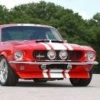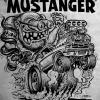Quel carbu edelbrock?
#2

Posted 08 June 2009 - 06:35 PM
#4

Posted 08 June 2009 - 07:19 PM
#5

Posted 08 June 2009 - 08:09 PM
#11

Posted 11 June 2009 - 06:43 PM
Bha c'est pas dur :
Si la caisse marche fort, c'est un 750
Si elle marche normalement, c'est un 650
Si elle avance pas, c'est un 600




Et dire que mister Bruno ( BN ) m'a mis sont 600 cfm de coté en holley pour ma futur....
J'veux pouvoir envoyer du gros moi aussi et pas etre une lopette !

In the padawan I Trust !
#12

Posted 24 October 2009 - 12:55 PM
-1403
-2556
Quelqu'un sait décrypter ces chiffres?
Je vous met une ou deux photos. Ah oui et en passant, le ptit cylindre eloxé bleu marqué "Edelbrock" qui est juste avant le carbu sur la ligne de carburant c'est un filtre???
Merci!!!
EDIT: TAILLE DES PHOTOS, MERCI!!!
Edited by franckgras, 24 October 2009 - 01:19 PM.
#13

Posted 24 October 2009 - 01:04 PM
Vu la taille et vu qu'il a l'air relié uniquement entre la pompe et le carbu ... il y a de fortes chances que ce soit un filtre en effetAh oui et en passant, le ptit cylindre eloxé bleu marqué "Edelbrock" qui est juste avant le carbu sur la ligne de carburant c'est un filtre???
En passant ... première fois que je vois un montage propre pour l'essence avec un carbu Edelbrock ... sympa
Edited by TuxStang, 24 October 2009 - 01:05 PM.
#15

Posted 24 October 2009 - 01:14 PM
AH BON TIENS POURTANT UN GARS DU MCF ma dit qu'un 600 cfm c'est beaucoup trop gros pour un 289 ???????? qui croire?????? les avis semblent divergents .............Bha c'est pas dur :
Si la caisse marche fort, c'est un 750
Si elle marche normalement, c'est un 650
Si elle avance pas, c'est un 600




#16

Posted 24 October 2009 - 01:37 PM
Sur un 289 stock avec boitoto, un 500 ira bien, sur un 289 qui prend plus de 7000 tr et sort 430 cv il faut un 950.
Donc tout dépend de l'usage que l'on veut avoir de sa voiture et du niveau de préparation du moteur ;)
Un petit commentaire de Troy Patterson, un préparateur US de carbus :
Hello all, Nate told me about this thread so I thought I'd come over and share my two cents worth.
I am impressed that there seems to be more or better understanding here generally of the whole carb cfm issue than I often read.
I refer to my carbs based upon venturi diameter. The reason I do this is that it is the diameter of the venturi relative to engine displacement that determines the air speed or velocity through the carburetor - which I consider a critical factor to application.
As was alluded to, the limiting factor to carb sizing (at this point of development) is the ability to meter fuel accurately. So, we can keep increasing the size to the point the carb is no longer able to be sensitive and responsive to subtle changes or fluctuation in the metering signal. In the case of Nate's 289, it is running a 1.50" diameter venturi over a 1.75" butterfly base plate. On a flow bench, this works out to around 900 cfm. In my opinion, Nate's 289 / car combo could happily handle a 1.60" + diameter venturi / 1.75" butterflies (or 1000 + cfm) carb properly prepared.
When I started playing with carburetors, I to thought that smaller cfms equaled better throttle response. The logic seemed to make sense - high velocity = quick response, and to some degree it's true. However, as it turns out, small carb / high velocity is more forgiving of a poor tune (or calibration, I use these terms interchangeably) and therefore to the novice there is greater likelihood it will produce the "expected" results when tested.
As my understanding progressed and I was better able to tune the fuel curve to the engine's needs, I found that I could run progressively larger and larger carburetors without loss of tip-in throttle response or low end torque, and always making more torque and horsepower.
What's interesting to consider is that as the carburetor is increased in size, manifold vacuum @ WOT is less - less vacuum means (relatively speaking) more pressure - in the intake track to fill the cylinder. If you picture what's happening at the intake valve: flow into the cylinder is not initiated into the combustion chamber until the pressure is greater on the port side of the intake valve, than on the chamber side of the valve. A large venturi carburetor by reducing the vacuum in the intake @ WOT, effectively decreases the vacuum - effectively increasing pressure - at the port side of the intake valve. A little bit like adding boost compared to running a small carburetor isn't it!?
All this means flow will be initiated sooner therefore more air / fuel mixture will be feed into the cylinder - and more power will be made.
Where running large to really large venturi diameter carburetors get people into trouble is if the carburetor isn't tuned well to the application and / or if it is a conventionally built / modified carb intended for a more conventional / typical cfm to displacement application.
Another benefit (power producer) to consider when running larger cfm carburetors is that because air speed through the carburetor is lower (by virtue of the larger dia. venturi / butterflies), the air / fuel mixture enters the plenum chamber at with less velocity - which enables it to make the transition or turn (with fuel still in suspension) into the intake runners. The little carburetors literally shot the fuel droplets straight at the floor of the plenum chamber.
By keeping a greater percentage of fuel in suspension vs. impinged on the floor of the intake manifold's plenum chamber and walls and running into the cylinder in fluid form, you maintain better fuel distribution of the a/f mixture reaching the combustion chamber therefore better combustion efficiency = better throttle response, more torque and horsepower.
Edited by thor_eyerdhal, 24 October 2009 - 01:41 PM.

http://www.turbo.fr/...i-ford-mustang/
Vidéos, principalement axées sur la sonorité :
http://www.youtube.c...pe=videos&uni=3
#18

Posted 24 October 2009 - 02:35 PM
Merci beaucoup pour vos infos! serai-je une lopette?

Pas toi mais ton carbu oui
 La Bullitt en photos et en vidéo : Youtube
La Bullitt en photos et en vidéo : YoutubePhoto Tatie 05/09/2012 : http://www.flickr.co...tream/lightbox/
#19

Posted 24 October 2009 - 04:36 PM
298ci stock + pipe edel.
alors qu'a 6000tr je consomme 350cfm....
il n'y a rien a comprendre mais le résultat est la.
West coast is the best !
Mustang Informatique
Mustang Web de Normandie
#20

Posted 24 October 2009 - 05:47 PM
euh ton moteur est stock ou préparé! le gas du mcf préconise un 500 cfm pour un stock! car il dit qu'un 600 est trop gros..... il m'a dit aussi que je consommerai plus pour aucun résultat ????? pas clair tout ça!je suis passé d'un 500cfm a un 600cfm et il n'y a pas photo.
298ci stock + pipe edel.
alors qu'a 6000tr je consomme 350cfm....
il n'y a rien a comprendre mais le résultat est la.
Reply to this topic
1 user(s) are reading this topic
0 members, 1 guests, 0 anonymous users




















